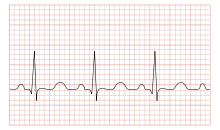tachycardia
English
WOTD – 14 February 2017

An electrocardiogram showing sinus tachycardia of about 100 beats per minute
_(14803245943).jpg.webp)
A diagram of the human heart, from Outlines of Human Physiology (1834)[1]
Etymology
From New Latin tachycardia, from Ancient Greek ταχύς (takhús, “swift”) + καρδία (kardía, “heart”), analysable as tachy- + -cardia; compare French tachycardie.
Pronunciation
- (Received Pronunciation) IPA(key): /tæ.kɪˈkɑː(ɹ).di.ə/
- (General American) IPA(key): /tæ.kɪˈkɑːɹ.di.ə/
Audio (AU) (file) - Rhymes: -ɑː(ɹ)diə
- Hyphenation: ta‧chy‧car‧dia
Noun
tachycardia (countable and uncountable, plural tachycardias)
- (medicine, cardiology) A rapid resting heart rate, especially one above 100 beats per minute. [from 19th c.]
- Synonym: tachyrhythmia
- Antonym: bradycardia
- 1896 June, E[dwin] M. Hale, “The Heart at the Beginning and Ending of the Menstrual Life: Reprinted from the Hahnemannian Monthly, June, 1896”, in The Hahnemannian Monthly, Philadelphia, Pa.: Homœopathic Medical College of Pennsylvania, →OCLC, page 1:
- The heart becomes irritable, there is nervous palpitation, or attacks of paroxysmal tachycardia.
- 1988, G.M. Woerlee, “Cardiac Arrhythmias – General”, in Common Perioperative Problems and the Anaesthetist (Developments in Critical Care Medicine and Anaesthesiology), Dordrecht: Kluwer Academic Publishers, , →ISBN, page 123:
- Tachycardias of all types reduce the cardiac output if the rate is high enough. […] The main difference between the tachycardias as regards the reduction of cardiac output is the rate at which they cause a significant reduction of cardiac output, and this depends on the type of tachycardia.
- 2003, Rebecca L. Cypher, Donna Adelsperger, Keiko L. Torgersen, “Interpretation of Fetal Heart Rate Patterns”, in Nancy Feinstein, Keiko L. Torgersen, Jana Atterbury, editors, Fetal Heart Monitoring: Principles and Practices, 3rd edition, Dubuque, Iowa: Kendall Hunt, →ISBN, page 117:
- Tachycardia is defined as a FHR [fetal heart rate] above 160 bpm that lasts for at least 10 minutes. Tachycardia represents increased sympathetic and decreased parasympathetic autonomic tone and, therefore, is generally associated with a normal loss of FHR baseline variability […].
- 2013, “Therapies and Treatments”, in Q. Ashton Acton, editor, Tachycardia: New Insights for the Healthcare Professional, Atlanta, Ga.: ScholarlyEditions, published 2013, →ISBN, page 235:
- With atrial tachycardia, the atria of the heart beats abnormally fast. Though often unpleasant for the patient, an atrial tachycardia is typically not fatal. However, some tachycardia, particularly ventricular tachycardia, can trigger ventricular fibrillation wherein the heart beats chaotically resulting in little or no net flow of blood from the heart to the brain and organs.
Derived terms
- atrial tachycardia
- sinus tachycardia
- tachycardiac
- tachycardic
- ventricular tachycardia
Translations
rapid resting heart rate
|
References
Further reading
 tachycardia on Wikipedia.Wikipedia
tachycardia on Wikipedia.Wikipedia - Colin McIntosh, editor (2013), “tachycardia”, in Cambridge Advanced Learner’s Dictionary, 4th edition, Cambridge, Cambridgeshire: Cambridge University Press, →ISBN, retrieved 14 February 2017, reproduced in the Cambridge English Dictionary website, Cambridge: Cambridge University Press.
- “tachycardia”, in Collins English Dictionary, accessed 14 February 2017.
- “tachycardia”, in Dictionary.com Unabridged, Dictionary.com, LLC, 1995–present, retrieved 14 February 2017, reproduced from Stuart Berg Flexner, editor in chief, Random House Unabridged Dictionary, 2nd edition, New York, N.Y.: Random House, 1993, →ISBN.
- “tachycardia”, in Merriam-Webster Online Dictionary, Springfield, Mass.: Merriam-Webster, 1996–present.
- “tachycardia”, in Lexico, Dictionary.com; Oxford University Press, 2019–2022.
This article is issued from Wiktionary. The text is licensed under Creative Commons - Attribution - Sharealike. Additional terms may apply for the media files.